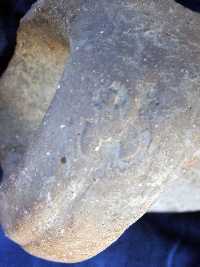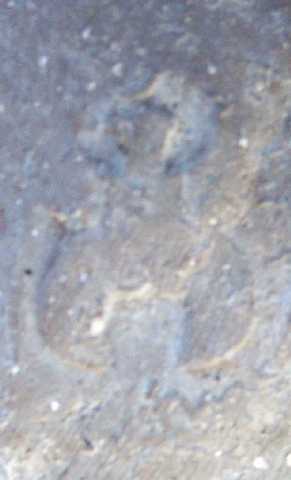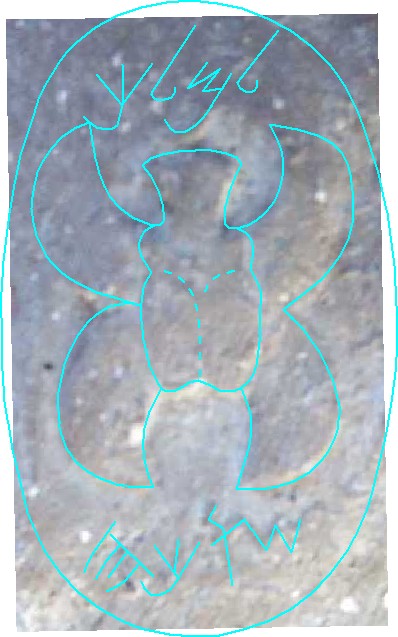I don't know who said it--possibly Lederman or Lipschits--but one of them quickly interjected, "Tel Aviv University protests [this statement]!" which was greeted with much laughter, but David Ilan just as quickly overruled them by saying, "Tel Aviv University can protest all it likes, [but since I'm presiding over this session, we're going to move right along...]"
Very funny stuff, which is why it's a shame they don't record these sessions. Interludes like this make the discussion all the more interesting, but it's completely absent from textbooks & journals. Pity.
Here's the lecture title & abstract:
"The MB, LB and Iron Age levels at Tell es-Safi/Gath: Update for the 2006 and 2007 seasons"
"During the 2006 and 2007 seasons at Tell es-Safi/Gath, strata dating to the Middle Bronze, Late Bronze and Iron Ages were uncovered. In this presentation I will present a preliminary description of these finds, including: first evidence of the MB II fortifications at the site; an additional Egyptian heiratic [sic] inscription dating to the end of the Late Bronze Age; early Iron Age (Philistine) remains, including hearths, an apparent Philistine cemetery; Iron Age II remains, including a unique bone tool workshop. The finds will be described and their cultural and historical significance will be discussed."
Until I started writing this blog, I had totally forgotten about his discovery of an exceptional cylinder seal with a lion portrayed like the one on the famous stamp-seal of "Shema, servant of Jeroboam" (WSS #2) from Megiddo. We were privileged to see it because I'm not aware of it even appearing on his own blog yet; he said it had been found the previous week. It's strictly iconic--no inscription--& dates to the Early Bronze III period (if my notes are correct). When he first looked at it, he didn't recognize any design on it, but after rolling an impression in Silly Putty, it was obvious (& quite impressive).
[Speaking of Silly Putty (i.e., something malleable that's easy to poke holes in), I'm going to insert a gratuitous editorial paragraph in here. For those not familiar with the Bible or with Minimalists or liberal theologians in general, the books of Judges & 2Chronicles were allegedly the works of liars with vivid imaginations who used the names of real people & real places to promote a fictitious history for a fictitious deity Who never really created anything & never really communicated with anyone. Amazingly, these writers were able to get an entire community to believe it was genuine, treat it as a sacred writing, build their lives around it, & promulgate it faithfully for over 2,000 years. End of editorial.]
Prof. Maeir gave us a great example of an artifact with a name similar to one mentioned in the Bible--an ostracon with Hieratic writing in ink, possibly reading "...El, Prince of Saf...". Though the actual inscription is fragmented, the name may be Saphita or Sephata like those in Judges 1:17 & 2Chronicles 14:10 (or 14:9 if you have a Hebrew Bible) with similar spellings, & it predates the supposed composition of the Bible by centuries (i.e., Bronze Age). For details & formal references, visit his blog entry, "Article on Hieratic Sherd from Safi in new ZDPV".
His lecture proceeded at a swift pace, showing a wide array of photos from the site including an Iron-I-era tabun (i.e., an oven) in Area A. Area T contained a Philistine burial cave, & he noted that very few have ever been found & documented. About 150 people were buried there, & he noted that this should satisfy the skeptical historians who ask, "Where are the dead Philistines?"
He showed several ornaments described as a hanging apparatus--apparent from its perforations--& humorously suggested it may have been "baby Goliath's mobile."
In the Iron-IIA era, the inhabitants expanded the site to the north, & he showed a "bone-tool workshop" featuring bone artifacts in various stages of construction, thereby illustrating what he called a "chaine operatoire" in Iron Age technology.
He closed his 25-minute presentation with his coincidental find of an S4L handle:



This 3rd photo contains the S4L seal template overlaid on the partial impression to show the entire design. Notice the excellent alignment of the scarab icon (especially the faint outlines of the thorax & elytra) relative to the bottom of the Mem, & the top of the Vau; just a little skewing makes the Shin & right wings appear wider than the template.
[Another editorial: I constructed this seal template primarily from several S4L handles containing ancient Israelite inscriptions purchased from IAA-licensed antiquities dealers, & exported with IAA-permits to me in beautiful downtown America. Every time I place these templates over specimens excavated from IAA-controlled scientific excavations like this, they always end up matching relatively well (allowing for a small amount of skewing due to the curvature of the jar handle &/or deformation of the clay &/or the plane of the impression not necessarily being perfectly parallel to that of the camera lens). Imagine that--a scientifically precise/accurate drawing that can be used freely by scholars around the world, made by an antiquities collector in a foreign country who likes to ride a bicycle & whistle at attractive ladies--who would've guessed?!]
You cannot imagine what a thrill it was for me to be able to attend a lecture by a principal archeologist announcing the discovery of one of these handles to his peers! And especially at such an important site so near to one with the very name of Biblical Sokoh! Truly a Wow-Day for me!
The 5-minute Q&A session began with Dr. Larry Stager, seated directly behind me, doing his best to rain on Maier's informative parade by asking, "When will we see Mycenaean 3 that will prove it's Gath? When [will you find Mycenaean 3 artifacts] in-situ with strata & occupation [evidence]?", thereby implying that all of the great P.R. work Prof. Maier has done may be premature. He began to reply with a pacifying reassurance, "It's there, it's just a matter of...", & Stager humorously interjected "...finding it?" After some laughter, Prof. Maeir listed several examples of Mycenean material already found at the site.
[Another editorial: I'd like to suggest that if you ever do find this Mycenean-3 stratum that you dump your conventional classification system & name it The Stager Stratum!]
And the final one was a you-had-to-be-there-to-see-and-hear-it-for-yourself-to-believe-it question, "Does that Goliath shard actually contain the name of Goliath?" This was a sincere person, but it shows how some people, even though they are savvy enough to attend an in-crowd event like this ASOR conference, simply don't do any of their own research, & get swayed by hearsay & misinformed media reports (like those who believe it's illegal to export any inscribed artifact from Israel). Prof. Maeir calmly (much more calmly than I would've been) reassured them that the artifact is "not Goliath for sure."
After reading his fun blog for so many months, & eating my heart out every time he describes one of his lectures, it was totally fulfilling to be able to see/hear one in person! Thank you so much for visiting California, Prof. Maeir! I'll admire you just the same even if you never find that undisturbed Mycenean-3 layer, or Goliath's skeleton!
G.M. Grena

No comments:
Post a Comment